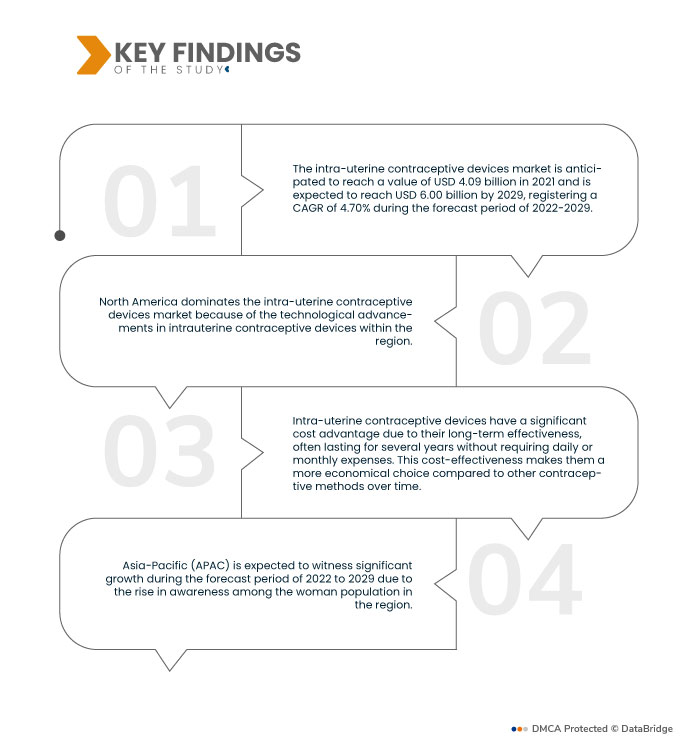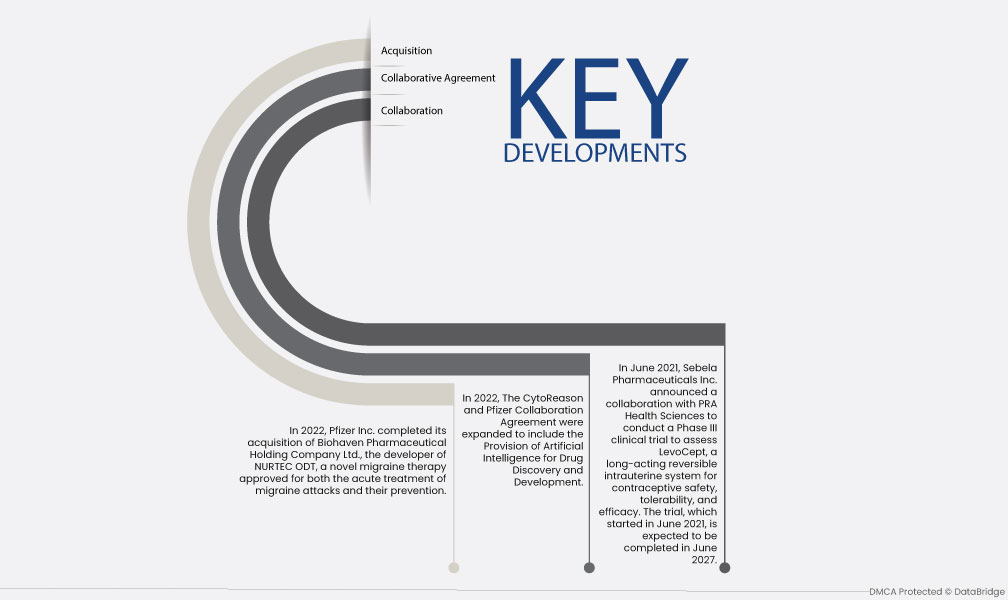Глобальный рынок внутриматочных контрацептивов переживает значительный подъем, предоставляя женщинам безопасные и эффективные решения для планирования семьи. Эти устройства предлагают долгосрочную контрацепцию с высокой эффективностью и удобством. Рынок выигрывает от повышения осведомленности о репродуктивном здоровье и необходимости надежных методов контроля рождаемости. В результате все больше женщин выбирают внутриматочные контрацептивы из-за их обратимого характера и минимальных побочных эффектов. Благодаря поддерживающей нормативной базе и расширению доступа к здравоохранению рынок обещает более светлое будущее для репродуктивного выбора женщин во всем мире.
Доступ к полному отчету: https://www.databridgemarketresearch.com/reports/global-intra-uterine-contraceptive-devices-market
Data Bridge Market Research анализирует, что рынок внутриматочных контрацептивов, как ожидается, вырастет до 4,09 млрд долларов США в 2021 году и, как ожидается, достигнет 6,00 млрд долларов США к 2029 году, регистрируя среднегодовой темп роста 4,70% в прогнозируемый период 2022-2029 годов. Негормональные внутриматочные средства привлекательны для женщин, ищущих контрацепцию без гормональных побочных эффектов, предоставляя альтернативу традиционным гормональным методам.
Основные выводы исследования
Ожидается, что рост участия женщин в рабочей силе будет способствовать темпам роста рынка.
С ростом участия женщин в рабочей силе женщины ищут варианты контроля рождаемости, которые предлагают удобство и надежность для эффективного управления карьерой и планирования семьи. Внутриматочные контрацептивы отвечают этим требованиям, поскольку они обеспечивают долгосрочную контрацепцию без ежедневного соблюдения. Эта возросшая потребность в практичных и надежных методах контроля рождаемости приводит к более высокому спросу на внутриматочные спирали среди работающих женщин. Предлагая гибкость, позволяющую сосредоточиться на профессиональном росте, сохраняя репродуктивный выбор, эти устройства становятся предпочтительным вариантом на рынке.
Область отчета и сегментация рынка
Отчет Метрика
|
Подробности
|
Прогнозируемый период
|
2022-2029
|
Базовый год
|
2021
|
Исторические годы
|
2020 (Можно настроить на 2014 - 2019)
|
Количественные единицы
|
Выручка в млрд долл. США, объемы в единицах, цены в долл. США
|
Охваченные сегменты
|
Тип (гормональная внутриматочная спираль, медная внутриматочная спираль), Тип продукта (Mirena, Skyla, Paragard, Essure, Levosert и другие), Конечный пользователь (больницы, гинекологические клиники, общественные центры здравоохранения и другие)
|
Страны, охваченные
|
США, Канада и Мексика в Северной Америке, Германия, Франция, Великобритания, Нидерланды, Швейцария, Бельгия, Россия, Италия, Испания, Турция, Остальная Европа в Европе, Китай, Япония, Индия, Южная Корея, Сингапур, Малайзия, Австралия, Таиланд, Индонезия, Филиппины, Остальная часть Азиатско-Тихоокеанского региона (APAC) в Азиатско-Тихоокеанском регионе (APAC), Саудовская Аравия, ОАЭ, Южная Африка, Египет, Израиль, Остальной Ближний Восток и Африка (MEA) как часть Ближнего Востока и Африки (MEA), Бразилия, Аргентина и Остальная часть Южной Америки как часть Южной Америки
|
Охваченные участники рынка
|
Teva Pharmaceutical Industries Ltd. (Иерусалим), Bayer (Германия), EUROGINE (Испания), CooperSurgical Inc. (США), Pfizer Inc. (США), HLL Lifecare Limited (Тируванантапурам), OCON Medical Ltd. (Израиль), Prosan International BV (Нидерланды), Melbea Innovations (Венгрия), Allergan, Merck & Co., Inc. (США), DKT International (США), Medisafe Distribution Inc. (Канада), Medicines360 (США), Pregna International Limited (Индия) и Egemen International (Турция) и другие
|
Данные, отраженные в отчете
|
Помимо аналитических данных о рыночных сценариях, таких как рыночная стоимость, темпы роста, сегментация, географический охват и основные игроки, рыночные отчеты, подготовленные Data Bridge Market Research, также включают в себя углубленный экспертный анализ, эпидемиологию пациентов, анализ воронки продаж, анализ ценообразования и нормативную базу.
|
Анализ сегмента:
Рынок внутриматочных контрацептивов сегментирован по типу, типу продукта и конечному пользователю.
- По типу рынок внутриматочных контрацептивов сегментируется на гормональные внутриматочные спирали и медные внутриматочные спирали.
- По типу продукции рынок внутриматочных контрацептивов сегментируется на Мирену, Скайлу, Парагард, Эссуре, Левосерт и другие.
- В сегменте конечного потребителя рынок внутриматочных контрацептивов сегментирован на больницы, гинекологические клиники, общественные центры здравоохранения и другие.
Основные игроки
Data Bridge Market Research признает следующие компании основными игроками на мировом рынке внутриматочных контрацептивов: CooperSurgical Inc. (США), Pfizer Inc. (США), HLL Lifecare Limited (Тируванантапурам), OCON Medical Ltd. (Израиль), Prosan International BV (Нидерланды), Melbea Innovations (Венгрия), Allergan, Merck & Co., Inc. (США), DKT International (США), Medisafe Distribution Inc. (Канада), Medicines360 (США)
Развитие рынка
- В 2022 году компания Pfizer Inc. завершила сделку по приобретению Biohaven Pharmaceutical Holding Company Ltd., разработчика NURTEC ODT — нового препарата для лечения мигрени, одобренного как для острого лечения приступов мигрени, так и для их профилактики.
- В 2022 году Соглашение о сотрудничестве CytoReason и Pfizer было расширено и теперь включает предоставление услуг искусственного интеллекта для поиска и разработки лекарственных препаратов.
- В июне 2021 года компания Sebela Pharmaceuticals Inc. объявила о сотрудничестве с PRA Health Sciences для проведения клинического исследования фазы III для оценки LevoCept, обратимой внутриматочной системы длительного действия на предмет безопасности, переносимости и эффективности контрацепции. Испытание, начавшееся в июне 2021 года, как ожидается, будет завершено в июне 2027 года.
Региональный анализ
Географически в отчете о мировом рынке внутриматочных контрацептивов представлены следующие страны: США, Канада и Мексика в Северной Америке, Германия, Франция, Великобритания, Нидерланды, Швейцария, Бельгия, Россия, Италия, Испания, Турция, остальные страны Европы в Европе, Китай, Япония, Индия, Южная Корея, Сингапур, Малайзия, Австралия, Таиланд, Индонезия, Филиппины, остальные страны Азиатско-Тихоокеанского региона (APAC) в Азиатско-Тихоокеанском регионе (APAC), Саудовская Аравия, ОАЭ, Южная Африка, Египет, Израиль, остальные страны Ближнего Востока и Африки (MEA) как часть Ближнего Востока и Африки (MEA), Бразилия, Аргентина и остальные страны Южной Америки как часть Южной Америки.
Согласно анализу Data Bridge Market Research:
Северная Америка будет доминирующим регионом на мировом рынке внутриматочных контрацептивов в прогнозируемый период 2022-2029 гг.
Доминирование Северной Америки на рынке внутриматочных контрацептивов можно объяснить ее постоянным вниманием к технологическим достижениям в этой области. Мощные инициативы региона в области исследований и разработок приводят к внедрению инновационных и улучшенных внутриматочных контрацептивов с улучшенным пользовательским опытом и эффективностью. Эти достижения создают конкурентное преимущество для североамериканских производителей, привлекая как внутренних, так и международных клиентов и способствуя лидирующей позиции региона на мировом рынке.
По оценкам, Азиатско-Тихоокеанский регион станет самым быстрорастущим регионом на мировом рынке внутриматочных контрацептивов в прогнозируемом периоде 2022–2029 гг.
Ожидается, что в Азиатско-Тихоокеанском регионе будет наблюдаться существенный рост рынка внутриматочных контрацептивов. Этот рост можно объяснить растущей осведомленностью женщин в регионе о репродуктивном здоровье и планировании семьи. По мере повышения осведомленности и улучшения образования в области контрацепции все больше женщин, вероятно, будут рассматривать внутриматочные спирали как надежное и удобное решение для контроля рождаемости, что приведет к расширению рынка в Азиатско-Тихоокеанском регионе.
Более подробную информацию об отчете о рынке внутриматочных контрацептивов можно получить здесь – https://www.databridgemarketresearch.com/reports/global-intra-uterine-contraceptive-devices-market












